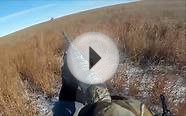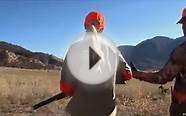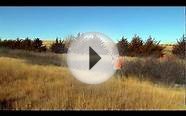Colorado pheasant hunting season
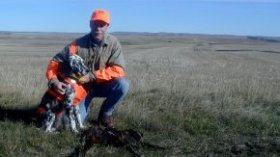
Unconventional Strategies for Hunting Late-Season Pheasants
— Article and photos by Tom Remington
Pheasant hunting is almost never easy, but hunting late-season pheasants can be particularly challenging. In December and January, you may be chasing less than half the roosters available in November. The survivors are battle hardened and educated to the ways of hunters and bird dogs. Pheasants learn to avoid draw bottoms, fence lines and other linear covers preferred by hunters and, instead, move to the middle of large fields.
My friends and I, through years of hard experience, have developed some unconventional strategies that work well late in the season. Roosters respond to hunters in predictable ways, and these tactics can help you take advantage of pheasant behavior.
Plan Where to Hunt:
By this time in the season, crops have been harvested and pheasants have settled into a pattern of feeding in corn or wheat stubble and roosting at night in adjacent Conservation Reserve Program (CRP) fields or wheat stubble that is tall and/or weedy enough to hide them.
A study of radio-marked pheasants in the 1990s in eastern Colorado, revealed 45 percent of pheasant locations from November to January were in CRP; 37 percent were in wheat/small-grain stubble; 9 percent were in corn stubble; and 9 percent were located in creek bottoms, windbreaks or weedy areas such as abandoned farmsteads. Habitat use will vary based on local conditions, but the take-home message is if you are not hunting CRP or wheat or corn stubble, you are hunting about 9 percent of available birds.
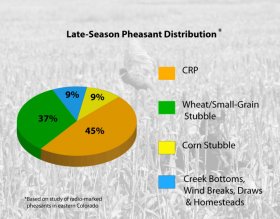 In Colorado, pheasants spent their entire life within a mile or two of where they were hatched, so find the best combination of food (primarily corn or wheat stubble) and cover within a section and hunt that area.
In Colorado, pheasants spent their entire life within a mile or two of where they were hatched, so find the best combination of food (primarily corn or wheat stubble) and cover within a section and hunt that area.
Hunt Unconventionally:
In most fields, there is an obvious place to park and obvious direction to hunt, and pheasants will have figured out escape strategies accordingly. My advice is to do the opposite: Rather than hunt from the road in, walk all the way around and hunt back toward the road. If hunting corn or sorghum stalks, hunt against the rows rather than walking down the rows and allowing birds to run ahead. If you hunt perpendicularly to the rows, birds attempting to run away will encounter your hunting partner instead.
This time of year, pheasants will either run a lot or not at all. The key is to hunt slowly enough to allow the dog(s) to find the birds that hold, and also have strategies in mind to get shots at the birds that run, which will be most of them. In addition, it makes no sense to push birds toward cover that you don’t have access to. Pushing pheasants toward green wheat fields or road edges is better, but late-season roosters will often flush or run across these breaks. Conventional walk-and-block strategies often result in birds flushing 100 yards from both groups.
Rather than use a static block, try to surround pheasants. Hunting in larger groups will facilitate surround strategies, but even two hunters can accomplish this by hunting toward each other rather than hunting side by side. Make certain that hunters know to only shoot at birds outside the circle or well above it to ensure safety.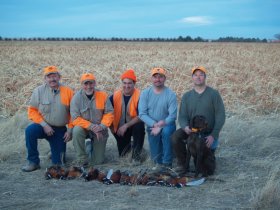 If hunting with smaller groups try to funnel birds into smaller areas that even three or four hunters can surround, such as the corner of a field or in irrigated areas, pushing birds from a quarter section into an adjacent pivot corner with cover.
If hunting with smaller groups try to funnel birds into smaller areas that even three or four hunters can surround, such as the corner of a field or in irrigated areas, pushing birds from a quarter section into an adjacent pivot corner with cover.
During a particularly memorable January hunt in Kansas, we watched a good-sized group of pheasants fly out of corn stubble and into a CRP field. It was a square mile in size — daunting for a group even as large as the eight of us. We hunted it in strips, with four walking toward the other four. My notes indicate we killed seven birds, but we watched far more fly away, out of range. The next day we tried it again, but this time our group spread out around the entire section and walked toward the center of the field. Initially we felt a little silly as we were half a mile from the next hunter, but the strategy proved effective, as birds running from one hunter would encounter an opposing hunter and freeze. As the circle tightened, birds began flushing in front of us in big numbers, and when the dust settled we had bagged 20 — almost triple what the walk-and-block strategy had yielded.
Conventional wisdom says hunt very slowly, but it is important to close the circle expeditiously when surrounding pheasants. They are not used to this tactic but if you give them enough time, they will find an escape route. Otherwise, be unpredictable in direction and speed to unnerve tight-holding roosters, particularly if you are hunting without a dog. Pheasants will often run a short distance to the side of hunters and then hold, so a zig-zag pattern is effective to flush birds. If using a dog, watch it closely and be prepared to keep up to maintain shotgun-range at birds that flush 30 yards ahead of the dog, which is typical in late season. Varying your speed and moving both quickly and slowly is effective, but you need to trust the dog and not call them off running roosters. At times, pursuing birds that are running will be the ONLY opportunities that you’ll have late season. If you want “quality dog work” with a pointer, hunt bobwhites!
You might also like


